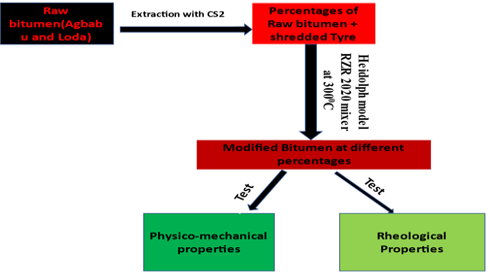Document Type : ORIGINAL RESEARCH ARTICLE
Authors
1 Department of Science Laboratory Technology, Rufus Giwa Polytechnic, Owo, Ondo State, Nigeria
2 Department of Industrial Chemistry, Federal University, Oye - Ekiti, Ekiti State, Nigeria
Abstract
BACKGROUND AND OBJECTIVES: Optimization of bitumen with Polymer modification such as a shredded tier, which serves as a waste in the environment has been used for road pavement to minimize common failure mechanisms associated with roads. The objectives aimed at using a shredded tier to modified bitumen (STMB) in ratio10:90, 20:80, 30:70, 40: 60, and 50:50, from Shredded tier were added to bitumen from Agbabu and Loda to study their performances when applied in the construction industry.
METHODS: Bitumen, which was obtained from Odigbo and Irele Local Government Area of Ondo State, Nigeria, was mixed at 3000C for two hours at different proportion with a shredded tier. Characteristics such as Penetration, Viscosity, melting point, marshal Stability, specific gravity and mechanical properties were determined.
FINDINGS: Marshall Stability (kg) at 600C increased with an increase in shredded tier modified bitumen from10% to 40% improved performance in both modifications and reduced in a 50% increase. This indicated that the increased in shredded tier reduced the measured value of penetration after the attainment values of 40:60 blends. This interaction between the bitumen-tier blends has a penetration value adequately agreed with the predicted value by the penetration index model. The rheological properties from different proportions at temperatures ranging from 450C to 650C at 40% modification were observed to have the least rutting parameter at 3.9 (G*/Sin δ (kPa) in Agbabu and 2.91(G*/Sin δ (kPa) in Loda for defects accountable to paving deformation and ageing as there was a decrease in the rutting parameter with the increase in temperature generally.
CONCLUSION: Generally, the values obtained for the physico-mechanical properties increased with an increase in modifiers from 10% to 40% modification in the two samples. Though, Agbabu is preferable and economical due to the percentage yield for road construction.
Graphical Abstract
Keywords
Main Subjects
OPEN ACCESS
©2023 The author(s). This article is licensed under a Creative Commons Attribution 4.0 International License, which permits use, sharing, adaptation, distribution and reproduction in any medium or format, as long as you give appropriate credit to the original author(s) and the source, provide a link to the Creative Commons license, and indicate if changes were made. The images or other third-party material in this article are included in the article’s Creative Commons license, unless indicated otherwise in a credit line to the material. If material is not included in the article’s Creative Commons license and your intended use is not permitted by statutory regulation or exceeds the permitted use, you will need to obtain permission directly from the copyright holder. To view a copy of this license, visit:
http://creativecommons.org/licenses/by/4.0/
PUBLISHER NOTE
IJHCUM Publisher remains neutral concerning jurisdictional claims in published maps and institutional affiliations.
CITATION METRICS & CAPTURES
Google Scholar | DOAJ | Scopus | EBSCO | Internet Archive |Twitter |Mendeley
CURRENT PUBLISHER
Tehran Municipality: Tehran Urban Research and Planning Center



Send comment about this article